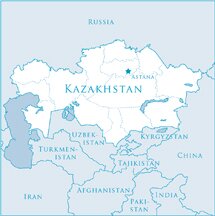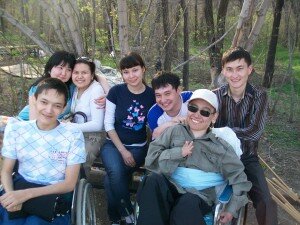A Returned Peace Corps Volunteer’s Story, Part 1
Today’s blog post comes from Perry Teicher, a Returned Peace Corps Volunteer who served in Kazakhstan from 2007-2009. This is the first of five posts about his Peace Corps service.
 While volunteerism as we usually view it in the States is a relatively new concept in Kazakhstan, community support is is engrained in traditions from Soviet times and earlier eras. During the Soviet Union, the first Saturday of every month would involve community cleaning. Everyone would be required to work together: doctors, nurses, and patients would clean the hospital grounds; administrators, teachers, and students would rake leaves in the schoolyard. The Kazakhstani government continues to organize similar morning activities.
While volunteerism as we usually view it in the States is a relatively new concept in Kazakhstan, community support is is engrained in traditions from Soviet times and earlier eras. During the Soviet Union, the first Saturday of every month would involve community cleaning. Everyone would be required to work together: doctors, nurses, and patients would clean the hospital grounds; administrators, teachers, and students would rake leaves in the schoolyard. The Kazakhstani government continues to organize similar morning activities.
Kazakh tradition contains a concept called “asar”, the idea of supporting your immediate community, a concept vital for allowing nomadic culture to survive for generations. Under this paradigm, all members of the community took responsibility for each other. For example, if a neighbor’s yurt (a mobile residence) burned down, the neighbors would help rebuild; if a family was low on food, the village would provide support. These traditions are important considerations in developing sustainable and potentially more effective volunteerism programs, in Kazakhstan as well as in America.
 I worked at the “Society for the Protection of Paralyzed Citizens of Aktobe”, a local NGO focused on creating an environment where people with disabilities could lead independent lives. To this end, the director, , wanted to create a “Volunteer Club”, where young people could work alongside disabled community members to establish friendships, bridge divides, and provide support for this vision.
I worked at the “Society for the Protection of Paralyzed Citizens of Aktobe”, a local NGO focused on creating an environment where people with disabilities could lead independent lives. To this end, the director, , wanted to create a “Volunteer Club”, where young people could work alongside disabled community members to establish friendships, bridge divides, and provide support for this vision.
already had an active volunteer contingent that consisted of generally older friends. We had the vision to expand this group of individuals engaging in one-time activities into a sustainable organization. This process involved a number of challenges:
1) Determining our target group We focused on university-age students and young professionals in order to work with those who could devote time and would be mature enough to work with people with whom they may be uncomfortable.
2) Overcoming the stigma of disability The word for a “person with a disability” in Russian is “invalid”. This word has relatively the same meaning in Russian as in English – worthless. Disabled individuals receive a pension and are expected to stay out of the public eye and be happy with their “free” money. Because the concept of disability rights is only just emerging, no infrastructure exists to help disabled individuals integrate into society. Some parents were very uncomfortable with the children working so closely with disabled youth.
3) Attracting volunteers Students in Kazakhstan are very busy, therefore we identified an easy source of volunteers – those students I already worked with at English Club. We focused on three main factors motivating volunteers: (1) English; (2) young American man; (3) helping the community. Number one and two served as a useful segway for the third. My Kazakhstani counterpart and I spoke at schools and students organizations to spread awareness and recruit volunteers. I took every opportunity to speak in front of group and in the media to talk about the volunteer club and provide contact information. We made it easy to find us.
 4) Training volunteers Volunteer training included physical and psychological preparations, such as how to use a wheelchair and strategies to deal with miscommunication. My Kazakhstani colleagues all had a physical disability and thus had greater credibility as they could speak from personal experience.
4) Training volunteers Volunteer training included physical and psychological preparations, such as how to use a wheelchair and strategies to deal with miscommunication. My Kazakhstani colleagues all had a physical disability and thus had greater credibility as they could speak from personal experience.
5) Retaining volunteers We started the process by anticipating that volunteers would want to take direction of the program. We quickly found we could more effectively retain volunteers when initial program ideas were top-down. We organized specific events and paired volunteers with “buddies” (young adults and children with disabilities). This enabled the volunteers and disabled youth to become comfortable and to build friendships within the context of the new organization. We made it easy for volunteers to invite their friends to activities.
This foundation then allowed us to focus on integrating the club into the community.
 Perry Teicher is a Returned Peace Corps Volunteer (Kazakhstan, 2007-2009). He is Co-Founder and President of TheGivingApp, L3C, a company focused on creating mobile applications for non-profits.
Perry Teicher is a Returned Peace Corps Volunteer (Kazakhstan, 2007-2009). He is Co-Founder and President of TheGivingApp, L3C, a company focused on creating mobile applications for non-profits.



3 Comments to “A Returned Peace Corps Volunteer’s Story, Part 1”